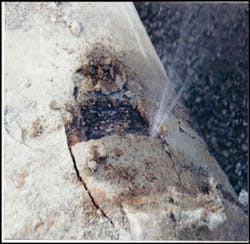The Big Question: How is technology helping to detect leaks under challenging conditions?
In the next part of WWi's technology comparison series, we look at leakage detection solutions. We ask suppliers how leaks can be located under each of the following challenging conditions: large diameter, non-metallic and lower pressure mains, as well as those located in urban conditions. Here's what they have to say.
Saying goodbye to a 'stick to the ear' approach
Dale Hartley, business development director, Syrinix
The regulatory definition of "Economic Level of Leakage" in England, the leakage rate below which leaks are deemed uneconomic to repair, has not moved for 10 years – a point that was not lost on the newspapers in 2012 when the country faced drought conditions.
Spurred on by that, and recognition from government and regulators alike that the ability to detect leaks has changed dramatically over that period, broad changes are expected to leakage targets in the next regulatory period in England. This is a challenge that utilities are already responding to.
To add to the challenge, and no matter how precious water might be, the reality is meanwhile that many economies, globally, simply cannot afford to respond by "pouring concrete". Alternative approaches to reducing leakage are increasingly a necessity.
Large diameter pipelines, plastic pipelines and low system pressures are, of course, synonymous with troublesome leak detection. The core issue is poor sound propagation in these pipelines, dramatically inhibiting leak detection using more traditional acoustic methodologies such as portable leak noise correlators, ground microphones and noise loggers.
Internal inspection techniques using a combination of acoustic sensor technology and live camera feeds can offer a short term 'mobile' option for finding leaks without disrupting water supply. There are disadvantages to such approaches including the cost and time of deploying teams to carry out the work, the need for traffic management and contamination risk. There is, of course, also the reality that the sheer size of networks means that few pipes are surveyed for leaks on an active, as opposed to reactive, basis.
Where major advances are being made is in completely removing the need for information gathering by deploying teams to the field unless and until problems are detected automatically.
One solution being increasingly applied is the application of algorithm based software, aggregating data across a network to identify problems areas.
In pursuit of automated leak identification, solutions are now combining analysis of flow, pressure and acoustic sensor technologies in single units with real time data graphically presented with automated precise alerts.
As such technology-based approaches become the standard, having a utility employee wear a bright yellow jacket and holding a stick to his ear really will become a thing of the past. Costs will be saved, responsiveness improved and, most importantly, leakage drastically reduced along the way.
Utility ApplicationWith 165 of Syrinix's TrunkMinder units being deployed across London, utility Thames Water is using the device to transform how it manages its critical trunk mains, allowing tiny leaks to be detected and located automatically so they can be repaired before deteriorating into major bursts. Using the devices, Thames Water's engineers can review the operation of those trunk mains in detail, gathering real time information from multiple units from PCs anywhere and when the information is required, not just when it is available. |
Avoiding cost and excavation in urban areas
Xiangjie Kong, director of research and development, Pure Technologies
Leaks in large diameter transmission mains should be of great concern to pipeline operators since the pressure and capacity results in a high level of water loss and are often a precursor to failure.
Inline leak detection can accurately locate leaks on large-diameter mains because it brings the leak sensor directly to the source of the leak and is not affected by the pipe's diameter. While non-invasive systems are very effective in small pipes, they lack the accuracy needed to address large transmission mains as the sound of a leak does not travel as well as pipe diameter increases.
Unlike structural condition assessment – which requires specific tools based on the pipe material – inline leak detection works on all pipe materials. Inline tools locate leaks based on their acoustic signature as the sensor passes the leak. Therefore, as long as water is leaving a pressurised pipe, the sensor will pick up the acoustic signature and detect the leak.
During an inspection, the leak sensor, whether tethered or free-flowing, is brought directly to the source of the leak, making it highly sensitive to the acoustic signature created by the leak.
When there is no flow, it is possible to pull the sensor through the pipeline using a winch system, making the tools effective in low pressure transmission mains.
Locating leaks in urban areas is particularly difficult as urban pipeline networks are often complex and the environment typically has above-ground obstructions.
In these areas, it is very important for leak detection tools to precisely locate leaks and estimate their size - excavation in an urban setting is costly. For that reason, tethered inline tools are very effective because they can be controlled closely by the operator and are tracked by a technician above the ground.
This allows the utility operator and leak detection staff to work closely to confirm the location of suspected leaks by winching the leak sensor back and forth. This method allows leaks to be closely located, which helps the utility in planning repair projects in high-traffic urban settings.
Uncovering network 'blind spots'
Benny Keinan, vice president of research & development, TaKaDu
Traditional methods for leakage detection are typically cost intensive and have some limitations related to the environment as well as mains' condition and type. Water Network Monitoring is a novel approach that overcomes these constraints, detecting and locating leaks as well as other water network anomalies through data analytics and statistical modelling.
Let's take Acoustic Surveys for instance. This is a physical method that requires field operations and manually checked data. It works well with metallic mains, but non-metallic pipes such as PVC or concrete pose difficulty since they transmit much less sound frequency than metallic pipes.
It can also be problematic to conduct Acoustic Surveys in noisy, urban environments.
Water Network Monitoring provides utilities with on-going visibility across their networks. Unlike the physical methods used to detect leaks, Water Network Monitoring can work with any type of pipe diameter or material as long as there is sufficient meter coverage along the network. The smaller the supply metered areas, the more focused and accurate the leakage detection becomes. Also, with frequent data transmission, monitoring becomes more effective since response times to network issues can be more immediate.
The use of Water Network Monitoring helps minimise water loss and energy consumption while optimising utility operations. This process is done automatically and remotely by processing available network data, therefore reducing detection cost and saving time to both back office and field teams. This approach is based on a utility's existing online data (e.g. flow, pressure, water quality) taken from sensors and loggers along the network as well as additional data sources (e.g. GIS, calendar, weather), all transmitted to a central location.
Collected information is then used to identify, characterise and alert on evolving conditions and trends, as well as to prevent or respond to various network inefficiencies such as leaks, bursts, zone breaches, meter faults and other operational malfunctions.
Water Network Monitoring systems can differentiate under any condition between a water loss event as opposed to real consumption. This approach helps utilities uncover network "blind spots", control water loss and even recognise small leaks before they become large.






